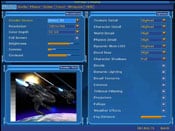 |
| click on picture for larger version |
Render Device
This allows you to choose what device will be used to handle
the graphics. If you have a 3D card, such as a nVidia GeForce
or ATI, choose “Direct 3D”. If you don’t
have one, choose “Software”.
Resolution
Choose how much of the screen you want to use. A higher resolution
provides more detail, but requires more resources. Unless
you have a very bad computer, you should stick with “1024x768”.
A power user can choose all the way up to 1600x1200.
Color Depth
Choose the depth of the colors used throughout the game. You
can choose between 16- and 32-bit. 32-bit makes everything
look nicer, but 16-bit is easier on underpowered systems.
Full Screen
Choose between playing the game like a normal game, or have
it in a window on your desktop.
Brightness/Gamma/Contrast
Change the various settings of colors. The image of the spacefighter
will change appropriately, and this is how the game will look
when you’re actually playing.
Texture Detail
Texture Detail changes how good the textures look. Textures
are wallpapers, floor coverings, etc. The higher the setting,
the better and sharper they look, but the more resources are
required.
Character Detail
This option changes how good the character models look. A
higher setting makes all the players look nicer and sharper,
but requires more resources.
World Detail
This option handles the graphics of the world, from the ground
and mountains to the sky and foliage. A higher setting makes
everything nicer, but needs more memory.
Physics Detail
This option handles the physics of the game. Physics means
the rag doll animations you see when you die, the way vehicles
explode and bounce around on the contours of the world, etc.
A higher setting makes everything cooler looking, but needs
more memory.
Dynamic Mesh LOD
This option changes how good characters look at a distance.
You can make it so characters look blocky, freeing resources,
or make them look clear at any distance, which takes up more
memory.
Decal Stay
This option determines how long decals stay in the world (bullet
holes, blood, etc.). A high setting leaves everything for
a longer time, but requires a lot of resources.
Character Shadows
This option determines how good the shadows of players look.
“Full” makes shadows look real, which could help
you locate hidden enemies. “Blob” is just a big
circle underneath the enemy, and “None” removes
them altogether. The higher the setting, the more memory that’s
required.
Decals
If enabled, decals will appear. If disabled, they won’t
be shown at all.
Dynamic Lighting
Changes whether dynamic lighting will be used. If you are
in a darkened corridor and you fire a rocket, the light from
the rocket will reflect off the walls, floor and ceiling.
Detail Textures
Adds some extra graphical power to the textures. Requires
more memory if enabled.
Coronas
Enables coronas. Requires more memory if enabled.
Trilinear Filtering
This enables an extra filtering method, which can make everything
look that much better. Turn it off to improve performance.
Projectors
Determines whether or not you see projectors.
Foliage
Determines whether or not you see foliage, such as grass,
trees, bushes, shrubs, etc.
Weather Effects
Will it be snowing in snowy maps? Will you see lightning off
in the distance? Turn off to improve performance.
Fog Distance
Determines how far in the world you can see. The farther to
the right you move the slider, the further you can see in
the game, but more memory is required.
|